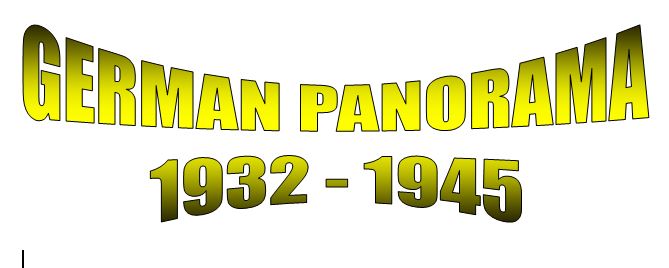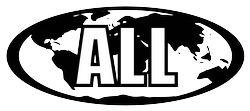11 DVD set about WWII Germany, from 1932-1945:


GERMAN PANORAMA # 01: 1932-1937
Wahlkampf in Eberwalde am See (1932): the struggle to win the upcoming elections is shown in this 13 minute film. Unfortunately, the quality of the film is only fair, with dark green tones and a logo in the upper left corner. lots of talking and speeches (yawn! :-);
Berlin im Olypmiajahr in Farbe (1936): in my opinion, the jewel of this DVD, this (unfortunately only) 9 minute color film about Berlin in the year of the 1936 summer olympics not only has excellent quality, but the Agfa color is simply outstanding. Were it not for the period idiosyncrasies and the old cars, one might think the film was recently made. NOT TO BE MISSED!!!;
Echo der Heimat #4 (1936): a montage of reports about Germany: guests get to tour a new German farm (with new German cows?); Bavarian loggers at work; expanding the Reichsbahn; new construction in Berlin. including the olympic stadium; a new Zeppelin is tested; the burial of Wilhelm Gustloff; the march into the Rhineland (25 minutes);
Ewige Wache - Feldherrnhalle (1936): soft quality film about the Feldherrnhalle in Munich. Lots of talk; blah, blah, blah (thankfully, only 9 minutes);
Echo der Heimat #5 and #5b (1937): the national get-together for 1937 (and in case you missed it the first time, it's shown again in the follow-up film); a celebration of the University of Heidelberg's 550th anniversary (now that's old!); the opening of the 1936 summer games in Berlin; 34 gold medals for Germany's youth in the Olympic games; a review of the events and their winners; The Rugen Dam is opened in Stralsund; the opening of the Winterhilfswerk for 1937 (35 minutes, soft quality throughout);
Echo der Heimat #6 (1937): 36 minute film of reports about Germany in 1937 with soft quality throughout: strikes and unrest plague the world; KdF brings relaxation and joy to Germany's workers; a visit with Mussolini; a return trip to Berchtesgaden for Il Duce; the trial of Wilhelm Gustloff's murderer in Switzerland; the RAD labor corps at work.
GERMAN PANORAMA # 02: 1937-1941
Gardetag in Dusseldorf (1937): Unnarrated color film some 7 minutes long documenting the celebration of Gardetag in Dusseldorf. Lots of soldiers and uniforms and music galore. Unfortunately, a soft VHS quality, but still worthwhile;
Cavalry Day (1937): another unnarrated color film some 6 minutes long documenting the Tag der Kavallerie in Germany. Again, lots of soldiers and uniforms and marching with happy-go-lucky music. And, once again, soft VHS quality (and STILL worthwhile);
A Montage of New Architecture in Germany (1938): This 15 minute, unnarrated film walks us on a tour throughout the new architecture in Germany built since 1933. But don't worry: in case you're alergic to museumlike silence, there's music to accompany you the whole way. Soft VHS quality;
The Sudetenland (1939): 14 minute photolecture on the Sudetenland's history and people, and culture, and landscapes, and history, and people ... oh! am I repeating myself?! Soft quality;
The Sudetenland, Part II (1939): This 29 minute film chronicles the events of 1938, when the Sudetenland was annexed by Germany after its shameful surrender by the British and French at Munich in an attempt to appease their way out of another world war. Guess what: it didn't work. Soft, soft, soft (sorta getting tired of repeating that!);
Ausser Gefahr (1941): Kinda strange, 25 minute film about air defence against British bombers, evacuating kids to the countryside to live wholesome lives without incendiaries dropping all around them and sidetrips into surreal topics I can't follow. Unfortunately, while this film DOES have narration, the sound quality is so bad, you'll think there's a Poltergeist mumbling in the background. Distorted color with occasional mini-lines throughout give the film an almost tinted black-n-white quality, making you wonder whether this was Ted Turner's first attempt at colorization. And, of course, soft quality again.
GERMAN PANORAMA # 03: 1932-1939
Youth in the Mountains (1932): What better way to get out of the Depression than to not be ... depressed! Yes, happy German boys and girls, confident in the future soon to come, but not yet there, get together for hikes in the Bavarian Alps; drilling; camping in army tents; horseplay and, of course, after a long day of marching and field work, what better way to end the day than with sleep under the starry sky, watched over by snowy mountains in the fresh spring air and the roadside shrine incongruously standing nearby? The film was put on VHS tape some 20 years ago or so and there's a timer in the upper left hand corner so you won't forget it (or, for that matter, forget how long you've been suppressing your yawns). Jerky movements here and there and soft quality throughout, but let's see if your grandfather can do any better after 75 years, pal! 20 minutes long and that's more than enough;
Die Stadt der sieben Turme - Rostock (1936): 14 minute film put out in 1936 about Rostock as the city, its people, culture and landscapes all looked like before the insanity of the Second World War changed it all forever. Decent VHS quality film throughout;
Give me four years time! (1937): After watching this 16 minute film, you'll be sure you've sat through it for four years! Impressive montage of what was done here, there, and everywhere and all throughout one man talking, talking, talking and claiming he was responsible for it all (and he could also paint a house in just one day ... two coats!). Soft VHS quality throughout; watchable, but who cares: you'll probably be asleep by Minute Five anyhow;
The Way in the World - German Youth Learn (1938): ... and do they ever! 20 minute movie-lecture lets you know that German youth have more to do than simply sit in a classroom and listen to ipods like your lazy kids ... nooooo .... there's the harvest to gather; lessons on how to be a farmer, a carpenter, a construction worker, etc. No importing foreigners to do the undesireable jobs in this country, thank you very much. Everyone studies and works and learns to fire a rifle ... good, clean, healthy living all around. Unfortunately, the neighbors at the opposite end of those rifles had a different opinion, don't ya know. Soft VHS quality throughout;
The Westwall (1939): 42-minute film tells you everything you could possibly have wanted to know about the Westwall on the French border: how it was built; who built it; why they built it; who stayed in it; what they did while there; how they entertained themselves when they weren't pointing cannons at Paris; how often they got to go outside and play and how much marching they did while enjoying the fresh air. 42 minutes, folks: surely, they had only to make the French watch this film and the campaign in the west would never have been necessary, for death would have come by boredom instead of shrapnel. However, for those of you out there into that military thang, you're sure to salivate at all the underground tunnels, cannons, uniforms, and so on. This almost 20 year old film has a counter in the upper left hand corner, too, so you can keep track of how long you were able to get through each attempted sitting. Soft VHS quality, but watchable. Some sound problems in parts of the film, but don't worry: it won't drown out your buddy's snoring in the lazy chair next to yours.
GERMAN PANORAMA # 04: 1939
Marine Report on the Battle for Danzig Bay (1939): Interesting 22 minute film, which, while not in the best of shape qualitywise, is very uncommon in its respectful tone for Polish resistance at Westerplatte, Danzig, Hel and the other battles for the Bay of Danzig in September/October 1939. Soft VHS quality throughout, but watchable and entertaining;
Eine Batterie geht in Stellung (1939): this 12 minute film has no narration at all, just martial music from the period. It concerns the maneuvers and operations of an artillery unit preparing for battle. At times, very soft VHS quality, but enough music to make anyone happy;
Glaube und Schonheit (1939): 15 minute film about the BDM, their training, how they spend their time at camp, how they spend their free time, how they should be an example for all good women everywhere. For the most part, good VHS quality;
Madel im Landjahr - 1. Teil (1939): another BDM movie, this time 23 minutes long, working on the same themes, but with some softer VHS quality film here and there. No narration; once again, lots of period music. Some jerkiness in the movement of the people in the film at points;
The RAD Men (1939): 24 minute film is the counterpart work to that about the BDM: half-naked youths grab their shovels to do public works projects, exercise, play, train, run, march ... you name it. No narration; again, lots of period music with some VHS softness here and there;
The Day of German Art (1939): this 17 minute film about the German art festival in Munich is an unfortunate disappointment, in that it is very soft. Watchable, but how sad that this rare color film suffers so horribly on quality. Lots of uniforms and art and so on. No narration, lots of period music;
Wagen Nr. 1 erkampft sich seinen Weg (1939): A 14 minute film about life in the snowed-in regions of southern Germany, where getting a doctor out to help you in times of distress is no easy matter. Here's what you can do to help yourself instead of waiting for Doc to hire a sled and make it through the ice and snow to your cabin in the mountains. Yodel-e-hi-ho! Some softness.
GERMAN PANORAMA # 05: 1940-42
The Battle of Norway (1940): Very good film about the Norwegian campaign with unusual candor is the jewel of this DVD. 81 minutes long with excellent quality;
Psst! The Enemy can hear You: Spy in the Train! (1940): 6 minute filmette was put out to be shown before movies in the theatre to remind people there was a war going on. In this film, a chatty woman with her dog in a train compartment spills out every military secret there is to know with the exception of where Hitler hides the family jewels to anyone who'll listen to her blabbing. Unbeknownst to her, there's a British spy on board and he's listening to it all. Even after she's warned to shut her trap and the spy is finally caught by the Gestapo, her only response is, "Oh! An extra seat for me to stretch out on!" Soft VHS quality, entertaining;
The Minister's Birthday Party (1942): it's even more ridiculous than it sounds. A 48 minute film made up of the private movies taken at the birthday party of a top minister on 28 October 1942. Uniforms, gala events and grand dames? Noooo ... just his brood of kids and a lot of movie about what's it like to live in his house *yawn*! Does give an idea, though, what it was like to hang out with the top leadership at the time. Soft VHS quality. Bring your pillow and blankie for this one!
GERMAN PANORAMA # 06: 1937-42
Festliches Nurnberg (1937): this 20 minute film about the national meeting in Nuremberg in 1937 is interesting, but suffers from unforgivable defects: jerkiness throughout the film, in some cases extreme; soft VHS quality; a greenish tint to the entire film. Aside from that, though, this film, which has no narration, but lots of music and sounds appropriate to the scenes is an excellent documentary not only on the political happenings of the time, but gives an impressive display of Germany's military prowess as shown during military exercises and reviews;
Hande am Werk (1938): curious to know how efficiently German industry performed in the last years of peace or how miners did their job? Well, this 48 minute film will tell all. Personally, I don't know how it would interest anyone, except those with an interest in such things, but the film was actually marketed for general consumption! (must have been a lot of insomniacs in Germany at the time hoping films like these would provide a much-needed cure). Soft VHS quality;
Ernst Udet, Ein Fliegerleben - Ein Heldenleben (1941): 15 minutes isn't too much time to dedicate to a national hero, now dead in battle, is it? Hopefully not, because that's how much time you're going to spend watching this film. Soft VHS quality, but watchable;
Flieger am Feind (1941): It's 1941 and you're inbetween invasions, with the war against Russia still to start and England being very uncooperative in the west by not surrendering. What do you do? Why, you make a film telling everybody how your air force with the grossly obese commander-in-chief is going to make England come to its senses, so you can all finally sit down to a gemutlich Viennese coffee with Schlag and some blueberry-topped Torte. Unfortunately, while Fatso Goring can eat cake, he can't bomb the British into submission. No narration for this 12 minute film, but lots of music to distract you from the soft VHS quality of the film. By the way, in the opening scene, don't be concerned that the bomber pilot looks like Putin ... it ain't him!;
Gebirgsjager und Biwak im Winter (1942): Finally! The ultimate instruction video for all those times you've been stranded out in 6 feet of snow and don't know how to build a snow cave to sleep in. This 32-minute film might have been practical for the elite German ski troops who had the energy, time and expertise to build three-man snow homes using their skis for roof supports and snuggling together with their buddies under wool blankets to stay warm at night, but I doubt the average soldier had either the time or inclination to expend such energy. But what do I know: it's only 96F in Phoenix today! Very good VHS quality film.
GERMAN PANORAMA # 07: 1942-43
Helferinnen der Wehrmacht (1942): this 2 minute film advertises the duties and responsibilities of those female helpers of the Wehrmacht, who played no less an important role in Germany's war effort than their male counterparts on the battlefield. Too bad, such a small amount of film is devoted to their accomplishments. Good VHS quality with some softness here and there;
Zeit im Bild: Soldaten in Eis und Schnee (1942): considering the contents of this 10 minute film, it is very likely that this was produced shortly after the begin of the first winter campaign on the Eastern Front --- by the second winter, the miseries of winter fighting in Russia became all too familiar to everyone to need such an apologetic film, which tries to make light of the hardships the Germans faced fighting both the Bolsheviks and General Winter. Good VHS quality film with some softness here and there;
Asse zur See - Unsere Schnellboote (1943): 18 minute work filmed, unfortunately for the most part, during night operations, shows the accomplishments of the German S-boats (sort of like PT boats) against the British. Very soft quality film, but watchable;
Brandschutz (1943): It says a lot about the state of the War in Germany, that by 1943, they felt the need to make public announcement films on how to combat incendiaries and put out fires correctly. This 4-minute film, whose point of centre takes place in an air raid shelter, is very informative and useful, even unto today. Good VHS quality with some softness;
Einsatz der Jugend (1943): This film also unintentionally portrays the true state of affairs in Germany in 1943, by, once again, starting off in an air raid shelter during a bombing raid by the English, even though the film has nothing to do with the subject. This 20-minute film concerns how the youth in Germany under new management have given up their class differences and work together to build a better society. Lots of community service shown and good ol' horseplay between the kids ... when they're not down in air raid shelters or doing duty as anti-aircraft helpers, that is. Very soft quality VHS;
In the Forests von Katyn (1943): An absolute propaganda blockbuster-event for the Germans, this 8 minute film shows the exhumation and presentation of evidence in the Smolensk area of Russia, where the Germans discovered the mass graves of over 12,000 Polish officers murdered by the Soviet NKVD in 1940. It was this event which led to the final break between Moscow and the London Poles and the Soviet denial of responsibility -- and their claims that the Nazis carried out the executions in 1941 -- remained a bone of contention, even in Communist Poland, where it was only discussed in whispers and sly smirks, until Gorbachev provided proof from KGB archival materials that the Russians actually committed the murders. Very interesting film; too bad only 8 minutes long. Some softness, but overall, good quality VHS material;
The training of the Elite (1943): An unfortunately very soft, VHS quality film 14 minutes long about the training of elite troops at Bad Tolz and their use in warfare;
Unsere Jugend - Ein Film der Napola (1943): Another film about an eilte training school and those who attend it. And, once again, unfortunately, this 18 minute film is very soft.
GERMAN PANORAMA # 08: 1933-37
Halle under the Swastika (1933): 10 minute film documents the going-ons of the new regime in Halle in the first year of the New Germany. Quite a bit of footage incorrectly attributed to other locations in other documentaries and films can be seen here, including the book burnings of 1933 at Halle's university and the filming of Red prisoners in the city's concentration camp. The film has no sound and there is some softness here and there, but overall in quite decent quality shape;
Blut und Boden (1933): the plight of the German peasant in Weimar Germany and the recovery and protection of the class in the New Germany is covered in this 28 minute film. There is some softness to the film and some minor sound problems here and there, as well as some jerkiness in the film, but overall in decent shape;
Fritz Todt - Zum Bau der Reichsautobahn (1933): Very brief, 2 minute film starring the head of the Labor Corps documents the accomplishments of expanding Germany's highway system in 1933. Some softness and dark tint;
Sondersendung der FOX Wochenschau (1933): 6 minute film about the political rallies in 1933. Soft VHS quality, dark green tint;
Im Lande Widikunds (1935): This 14 minute film is rather difficult to follow, but as best as I can make out, it has to do with some ancient settlements in Germany and the people's link to them in the New Germany. The film has a time in the bottom left hand corner, very soft VHS quality and some jerkiness. Not good quality at all, but worth its inclusion just to confuse you; maybe YOU can figure out the plot;
Tag der Freiheit - Unsere Wehrmacht (1935): What a shame this film is only 17 minutes long. Very good quality film about the German Army maneuvers of 1935 filmed and directed by that master Leni Riefenstahl;
Eroffnung des Winterhilfwerkes (1936): 3 minute film of speeches (in other words, a sleeper) opening the Winter Help Campaign for 1936. Some softness;
A Report about the Winter Olympics in Garmisch-Partenkirchen (1936): 32 minute film concerns the top events in the Winter Olympics in Germany in 1936. Soft VHS quality with some jerkiness here and there;
Elbing - Land on the Weichsel (1937): What a pity that the quality of this 11 minute film about Elbing (Elblag) is so poor. Oh well. Nonetheless, too important and rare a film to let get away, even if it's painful to watch.
GERMAN PANORAMA # 09: 1937-44
Die Kamera fahrt mit (1937): Delightful, 12 minute film about how the news is made in Germany. Not some dry, technical film, this work shows how cameramen film the current events, how they use their equipment and how the film is developed, edited and spliced. Events such as the Winter Olympics are used to demonstrate how it's all done. If you think you've ever wanted to work as a cameraman, this film will make you want to become one ... well ... at least 70 years ago anyhow. Lots of action and excitement and you can bet no writers or technicians went on strike here! Very good quality film;
Flieger, Funker, Kanoniere (1937): 11 minute film about the new Luftwaffe with English subtitles and very good picture quality. For any air force fans out there, a very interesting and exciting film;
Wort und Tat (1938): 10 minute montage of the events from the chaos of the late 20s and early 30s up til the time of the Anschluss of Austria in March 1938. Meant to demonstrate how times had changed. Oh boy: did they ever! Good quality film;
Fallschirmjager Training Film (1939): 15 minute training film about how paratroopers train to do their job. It's a good quality film, but there is some jerkiness and slow motion at points from the PAL transfer;
Sprung in den Feind (1942): Very good quality, 22 minute film concerning the invasion of Holland in 1940 with very good quality film of paratroopers invading and taking bridges, landmarks, etc. Ironically, the film has Dutch subtitles;
Gebirgsjager auf verschneiten Gletschern (1943): 20 minute training film for elite mountain troops on how to do their job in tough winter conditions. Overall, this has good film quality, but there are some focus issues, as this was meant to be a training film for internal consumption and the quality of the camera work was, therefore, not the best.;
Junges Europa (1943): 12 minute film on the training and education of German youth in wartime Europe. Good quality film, but there is a logo on the bottom right hand side of the screen;
The Jews of Theresienstadt (1944): In 1944, delegates from the International Red Cross were brought to Theresienstadt in the hope that their reports on the visit would quell worldwide rumours about the extermination of the Jews. Selected parts of the ghetto were cleaned-up and a fantasy world was created for the benefit of the neutral observers to show that all the resettlement camps in the East were just like Theresienstadt; just not so luxurious as here in the Paradise Ghetto. So well did the farce work, that the Germans decided to make a follow-up film to the visit. Entitled, Der Fuhrer schenkt den Juden eine Stadt, the movie portrays well dressed, happy and well behaved internees at work, at play, at cultural events, and so on. Given what we know now, the opening scene showing metal workers hammering away to the tune of the Can-Can is a bit unsettling, but it sets the tone for this Potemkin film of a Potemkin Village. Just as the majority of Europe's Jews had "disappeared" by the time this movie was made, so had most of this film disappeared by War's end. Only this 16 minute rare fragment exists. The completed film itself did not live up to the expectations of the Lagerkommandant, who wanted a masterpiece, but had to settle for something less, when he abruptly ordered a quick ending to the filming in the late summer of 1944: after reports about the liberation of Lublin and the extermination camp Majdanek in July 1944 started leaking out to the West, Commandant Rahm wanted the film quickly distributed for the purpose of "damage control". The discovery of mass graves and Zyklon B did not make the movie superflous, however, and Rahm need not have worried about rushing the film to the theatres: most Westerners did not believe the Russians' reports about the extermination camps in the East. Were it not for historical hindsight and the Jewish stars sewn on the garments of the "actors", the viewer of this film would think it was simply a kitschy film about village life in Europe. Watch closely, however: within months of the completion of the filming of this fragment, almost everyone seen in the film would be deported to Auschwitz and gassed. Good quality film, some softness;
Sturmsoldaten der Luft (1944): Another good quality, 15 minute film about German paratroopers;
Heimkehr ins Reich (1944): This 12 minute film has no sound, but, for the most part, good quality film detailing the annexations of Austria, the Sudetenland, Bohmen und Mahren and the Memelland. Not quite sure why they waited until 1944 to film the events, but history was to provide an ironic epilogue to the film: in less than a year's time, those who marched into and resettled these areas would be returning as refugees fleeing the Red Army on their heels.
GERMAN PANORAMA #10 (1937 - 1940)
WWII Germany in Color - Part II (1937-40): In the follow up to our other DVD, WWII Germany in Color, this 46 minute film shows what life in Hitler's Germany was like right before the outbreak of War up until the conquest of France. Color films, discovered by US forces only after War's end, make up the bulk of this collection of both home movies, movies shot by troops at the front with 8mm, compact cameras, and official productions. Quality varies by just who was shooting what, but they're all interesting, nonetheless. Narration in English;
Russian against Finn: 56 minute color film documents a subject rarely covered in the United States: the Russo-Finnish War of 1939-40. While not immediately about Germany, per se, the Soviets' poor performance in the Winter War led Hitler to call for the plans to invade Russia the following year, and thus had tremendous influence on the history of Europe and the world as a whole. This film documents not only the events of that fateful winter, but has wonderful re-enactment by Finns and Russians. Very interesting. Excellent quality. Mostly in English, but there is some Finnish and Russian with English subtitles;
GERMAN PANORAMA #11 (1940 - 1945)
WWII Germany in Color - Part III (1940-45): In the follow up to our other DVD, WWII Germany in Color, and the second part of the same shown in German Panorama # 10, this 56 minute film shows what life in Hitler's Germany was like from the end of the French campaign until the end of the War. Color films, discovered by US forces only after War's end, make up the bulk of this collection of both home movies, movies shot by troops at the front with 8mm, compact cameras, and official productions. Quality varies by just who was shooting what, but they're all interesting, nonetheless. Narration in English;
The German Sniper: This 68 minute film covers all aspects of training for the German sniper, including how to use one's weapon correctly and hide from the enemy. Excellent quality film with English narration and English subtitles;
The final film is a 9 minute selection taken from Finnish newsreels about the performance of the Finnish air force in the war against Russia. This 1941 film has no narration, just music and battle sounds. Quality is good, but there is a timer running through the whole 9 minutes. Rare and interesting.
IN GERMAN WITH NO SUBTITLES (except where otherwise listed). APPROXIMATELY 1360 MINUTES TOTAL (22,5 hours)





